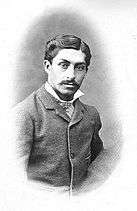Daniel Alcides Carrión
| Daniel Alcides Carrión García | |
|---|---|
|
Daniel Alcides Carrión García | |
| Born |
August 12, 1857 Cerro de Pasco, Peru |
| Died |
October 5, 1885 (aged 28) Lima, Peru |
| Nationality | Peruvian |
| Fields | medicine |
| Known for | Carrion's disease (Oroya fever) |
Daniel Alcides Carrión García (August 12, 1857 – October 5, 1885) was a Peruvian medical student after whom Carrion's disease is named.
Fatal experiment
Carrión described the disease in the course of what proved to be a fatal experiment upon himself in 1885, in order to demonstrate definitively the cause of the illness. He was inoculated by close friends with blood which had been taken from a wart of a 14-year-old patient.[1] Carrión's aim was to prove a link between the acute blood stage of Oroya fever with that of the later chronic form of the disease, called verruga peruana, typified by numerous red, wart-like dermal nodules. Neither the cause nor mode of transmission of Oroya fever was then known and, furthermore, the relationship between the acute and chronic forms of the disease was not yet proven. Carrión developed the classic symptoms of the acute phase of the disease, thereby establishing the link.
After Carrión's death from the disease, a fellow student who had assisted in the experiment was arrested for his murder, but later released.[2] In 1938 Maxime Hans Kuczynski survived a similar experiment.
Burial site
Carrión is buried in a mausoleum on the premises of the National Hospital Dos de Mayo in Lima.[3]
National Hero
On October 7, 1991, the Peruvian government announced a law (LeyNº 25342), declaring Carrión to be a "National Hero" (Spanish: Héroe Nacional).[4]
Named in his honour
- Carrion's Disease as an alternative name for Oroya fever.
- The Daniel Alcides Carrión Province in the Pasco Region.
- October 5 Day of Peruvian Medicine (Spanish: Día de la medicina Peruana).
- The Daniel Alcides Carrión National University (Universidad Nacional Daniel Alcides Carrion) in Cerro de Pasco.[5]
- The National Hospital Hospital Nacional Daniel Alcides Carrión in El Callao.
- The Estadio Daniel Alcides Carrión Stadium in the city of Cerro de Pasco.
See also
References
- ↑ Top 10 Researchers Who Experimented On Themselves; Top Tenz; accessed ???
- ↑ Cutis, vol. 48, iss. 4-6, p. 339, 1991.
- ↑ (Spanish) Department of Health / History of Dos de Mayo Hospital
- ↑ (Spanish) Ministerio de Salud – Detalles; Department of Health; accessed ???
- ↑ (Spanish) Official website of the National University Universidad Nacional Daniel Alcides Carrion
Notes
- Daniel Alcides Carrión, short biography on whonamedit.com.
- (Spanish) Gregorio Delgado García and Ana M. Delgado Rodríguez, Daniel Alcides Carrión y su aporte al conocimiento clínico de la fiebre de la Oroya y verruga peruana, Cuaderno de Historia, No. 80, 1995. First presented at I Congreso Nacional de Historia de la Ciencia y la Técnica. Havana, November 15, 1994.
| Wikimedia Commons has media related to Daniel Alcides Carrión. |
